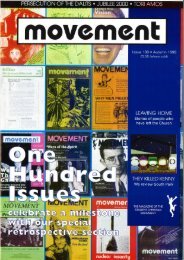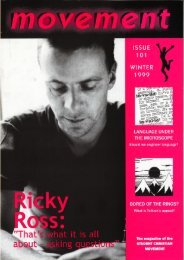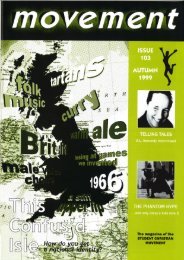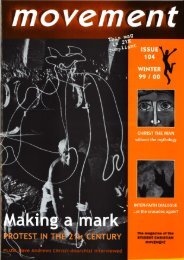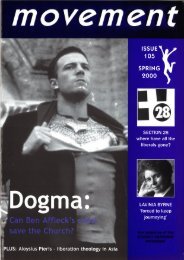Movement 107
You also want an ePaper? Increase the reach of your titles
YUMPU automatically turns print PDFs into web optimized ePapers that Google loves.
ooks<br />
Reinvenfing the ideal<br />
lf evolution, quantum plryslcs and arttficial intelli{ence are taken for {ranted,<br />
where does that leave our images of Gad? David ltl$fns explores<br />
EVER SINCE THE lnquisition condemned<br />
Galileo, science and Chtistianity have<br />
existed in tension with each other.<br />
But in recent years we have seen many scientists<br />
and theologians claiming that the two are in<br />
fact compatible. Ihis book is in that tradition: a<br />
collection of very short essays arguing for a positive<br />
view ofthe relationship<br />
between the two<br />
disciplines.<br />
There are fifty contributors, many of them eminent<br />
British or American theologians, but their<br />
pieces are designed to be accessible to a wide<br />
readership - the kind of thing you might find in a<br />
newspaper 0r magazine. Whilst there are a few<br />
essays by people of other faiths, most of the<br />
authors are Christians, and most of those happen<br />
to be Protestants. lf you are familiar with the science-and-religion<br />
debate, you will recognise many<br />
of the authors represented here. lnterestingly,<br />
there is no orthodox contribution at all.<br />
Ihe book falls into eleven sections covering<br />
areas like creation, genetics, evolutionary biology,<br />
and the limits of science. At the start of each one,<br />
Russell Stannard gives a summary of the pieces to<br />
follow, He does not have a hard job: most 0f the<br />
essays are concerned with making one simple<br />
point. Unlike much theological writing, they are<br />
admirably concise and clear. I cannot hope to tell<br />
you about all 0f the essays, but I'll pick out a few<br />
to give a flavour of the collection.<br />
Paul Davies points outthat, accordingt0<br />
modern physics, time came into being along with<br />
matter at the Big Bang. So asking what happened<br />
before the Big Bang is like asking what lies north<br />
of the North Pole. The Christian doctrine of creation<br />
cannot mean, in Davies' words, "God<br />
pushing a metaphysical button and sitting back to<br />
watch the action"llnstead, creation is "God sustainingthe<br />
existence ofthe universe, and its laws,<br />
at all times, from a location outside of space and<br />
time". lhe lawlike nature of the universe is a better<br />
starting-p0int for dialogue between science and<br />
religion than the meaningless question of what<br />
happened before the Big Bang.<br />
Anne Foersfs article on computers in the'Personhood<br />
and the Soul'section considers what it is<br />
that makes us people ratherthan machines. ls it<br />
our use of language or our capaci$ for abstract<br />
thought? Foerst rejectsthese ideas, saying<br />
instead that it is God's creation of us (and the<br />
relationship with him that he offers us) which<br />
makes us individuals. ln that case, there is no<br />
reason why a sufficiently complex computer could<br />
not be a person. Foerst is pointingto the relevance<br />
of theological thinking in the context of computer<br />
technology.<br />
God for the 21st Century I ed, Russell Stannard I SPCK<br />
One point that crops up several times in<br />
the book is the discovery that if the universe's<br />
basic physical laws had been just<br />
slightly different then human life could<br />
not have evolved. For instance, Michael<br />
Poole reminds us that afterthe Big<br />
Bang there were only the simplest elements,<br />
hydrogen and helium. These<br />
fused together in nuclear reactions<br />
at the centre of stars to give the<br />
more complicated elements, like<br />
oxygen and carbon, from which<br />
organic life is made, "But how<br />
do stars form in the first<br />
place?" Poole asks. "Through<br />
gravity compressing a cloud<br />
of gas, and ignitingthe nuclear<br />
fusion fires.... Make gravity any weaker, and the<br />
stars will not ignite. Make it any stronger, and the<br />
stars will burn too fast, and long-lived stars like<br />
the Sun will not exist." lhe universe seems to be<br />
fine-tuned for life.<br />
Not many people like to sum up theirthoughts<br />
in a few rhetorical paragraphs, and so its unfair to<br />
judge the contributors on what they say here. But<br />
one does not get much of a sense of an ongoing<br />
engagement from which these conclusions spring'<br />
ln this respect, Stannard's earlier book, Science<br />
and Wonders, is much better, containing as it does<br />
some sceptical material from such people as<br />
Richard Dawkins, lt would be a more helpful book<br />
to use if you are looking for material to spark off a<br />
discussion.<br />
-fn<br />
.ADBY<br />
Science is a method of arriving at conclusions through<br />
A tedious proportion of the essays in this book<br />
conclude with a paragraph of radiant optimism<br />
\s".eq<br />
aR rr,<br />
2li,'<br />
{f it ruRl<br />
trl<br />
.&tys5^-.<br />
-. r 5I4<br />
i",, , o<br />
conjecture and experiment. ln contrastto religion,<br />
science has been enormously successful.<br />
I<br />
26 lmovement<br />
lr











